Options for upgrading your equipment
If your equipment needs to be upgraded to accommodate voltage conversion, there are four options for doing that.
The four options vary in scope, benefits, cost, and timelines, but each will ultimately prepare your site for voltage conversion by replacing all 4 kV or 12 kV equipment with 25 kV equipment.
The right option for you will depend on the voltage rating of your primary service equipment, the space available at your site, and more. We'll work with you to determine the best solution.
- Option 1: Minor equipment upgrade
- Option 2: Install a step-down transformer
- Option 3: Major primary service equipment replacement
- Option 4: Remove primary service equipment, install secondary service
- Finding a qualified electrical contractor
What is primary service equipment?
Electricity for most buildings in B.C. is supplied from BC Hydro at secondary service voltage, which is 600 V or less. For some buildings, electricity is supplied at primary service voltage, which is 4 kV, 12 kV or 25 kV. The options below are relevant to you if you have primary service equipment at your site that needs to be upgraded.
Who pays for the upgrades?
BC Hydro will cover the cost of the lowest-price feasible option for upgrading your equipment.
Pros:
- Typically lower cost, if not the lowest cost, among the options.
- Minimal impact to your vault.
- Minimal effort required from you. Just join us for discussions and hire an electrical engineer to help plan the work, and an electrical contractor to be on site for the day of the conversion.
- You'll get some new equipment.
- You can leverage the outage on the day of the conversion to have your contractor also do some of your own maintenance work.
Cons:
- Minor outages required.
- We'll do a preliminary vault review to confirm that it's dual-rated for 12 kV and 25 kV.
- You'll need to hire an electrical contractor and/or engineer. They'll first review your vault to determine what needs to be done to convert the site from 12 kV to 25 kV, and send us the necessary documentation.
- We'll review the report. Once accepted, a funding agreement will be put into place outlining the terms of work and payments.
- Your electrical contractor will order the required conversion material and send us documentation for review.
- We'll coordinate with your contractor to complete the voltage conversion cutover. An outage will be required.
Timeline: To perform the equipment review, your contractor will typically request a four-hour outage (can be done overnight). When it's time to do the cutover, two outages will be required. The first will be about two hours (can be done overnight), and the second will be 10 to 12 hours.
Cost: About $60,000.
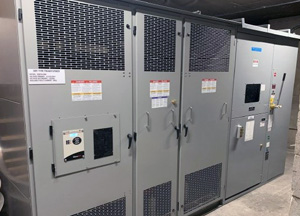
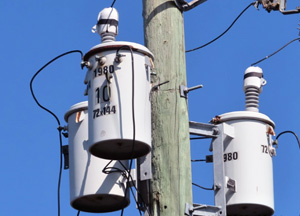
Option 2: Install a step-down transformer
With this option, the goal is to keep your existing primary service equipment unchanged. A step-down transformer – owned and maintained by BC Hydro – will be installed on your site between the BC Hydro service wire and your point of connection. Step-down transformers reduce the voltage from our new system voltage to your existing primary service voltage, 12 kV or 4 kV.
Pros:
- Typically the lowest-cost option, meaning it will be no cost to you.
- Minimal effort required from you. Just join us for discussions and hire an electrical contractor to be on site for the day of the step-down transformer installation.
- Minimal impact to your primary service equipment.
- BC Hydro owns and maintains the step-down transformer, so you won't have to worry about it.
- For smaller sites, the transformer may be mounted overhead on poles.
Cons:
- The step-down transformer will require adequate spacing, a 4.5 by 4.5 metre area, for our access and operations.
- If installed on private property, a statutory Right of Way will need to be filed at the land title office before installation.
- We'll confirm that a step-down transformer is feasible for your site.
- We'll determine the size and type of transformer that will work best and review potential site impacts.
- We'll work with you to coordinate installation of the new step-down transformer.
Timeline: Installing the step-down transformer requires one outage of about eight hours. Later, once the entire circuit you're on is ready for voltage conversion, an outage of about 10 to 12 hours will be required.
Cost: Since this is typically the lowest-cost feasible option, there's no cost to you. Some exceptions apply. The cost ranges from about $75,000 to $100,000.
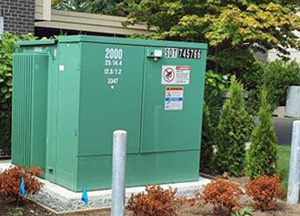
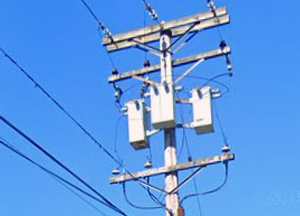
We offer a decorative wrap program for pad-mounted equipment boxes.
Pros:
- The vital components within your electrical vault will be replaced with brand new equipment.
- The new equipment will be compliant with all current standards and codes, creating a safer space.
Cons:
- Most expensive option.
- Longer timelines required to accommodate design and construction work.
- Your engineer must complete and submit comprehensive documentation for your service upgrade plans.
- Some equipment can have long lead times to deliver, up to a year or more.
- We'll do a preliminary vault review to confirm the voltage rating of your equipment. If it's found to be primarily 4 kV or 12 kV, we'll notify you that vault replacement is required.
- You'll need to hire an electrical contractor and/or engineer. They'll prepare a report of the vault conversion options for us to review.
- We'll review the report. Once accepted, a funding agreement will be put into place outlining the terms of work, payments and construction timelines.
- Your consultant will submit a detailed engineering package and specifications to us for approval before beginning construction. They'll also get the appropriate permits.
- Once the application and permits are approved, construction can take place.
- We'll perform inspections before the vault is energized.
Timeline: Replacing primary service equipment takes about one to two weeks, during which time your building would need to be placed on generator power. This requires two outages of up to four hours each, one when you're moved to generator power, and one when you're moved back. And when it's time to do the cutover for voltage conversion, that requires another outage of about 10 to 12 hours.
Cost: The cost ranges from $300,000 to $1 million.
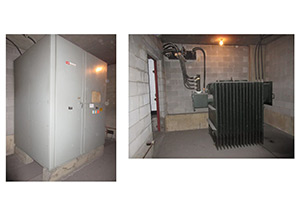
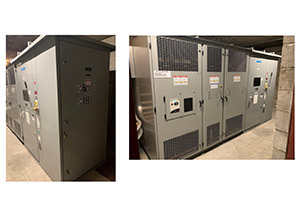
Option 4: Remove primary service equipment, install secondary service
With this option, all your 4 kV or 12 kV equipment is removed and replaced with lower-voltage equipment that's 600 V or under. It's suitable for sites that have some available space to work with on the property, or when existing equipment is aging.
Pros:
- Primary voltage equipment in your vault is removed, significantly reducing your future maintenance costs.
- BC Hydro owns and maintains the new primary voltage pad-mounted transformer outside the building, so you won't have to worry about it.
- Secondary service equipment is more standard than primary, which means it's easier for your contractor to work on.
- For smaller sites, the transformer may be mounted on overhead poles.
Cons:
- Longer timelines required to accommodate design and construction work.
- Your engineer will need to complete a detailed design for the new secondary service, which takes time.
- Some equipment can have long lead times to deliver, up to a year.
- The pad-mounted transformer will require adequate spacing, a 4.5 by 4.5 metre area, for our access and operations.
- If installed on private property, a statutory Right of Way will need to be filed at the land title office before installation.
- We'll do a preliminary review of your vault and property to confirm the voltage rating of your equipment and to see if space is available for a pad-mounted transformer.
- You'll need to hire an electrical contractor and/or engineer. They'll prepare a detailed design of the proposed secondary service and equipment locations.
- We'll review the design. Once accepted, a funding agreement will be put into place outlining the terms of work, payments, and construction timelines.
- Once the application and permits are approved, construction can take place.
- We'll perform inspections before the new service is energized.
Timeline: Depending on the complexity of the work required and the location of your new equipment, outage timing will be similar to option 2 or 3 above.
Cost: The cost ranges from $100,000 to $300,000.
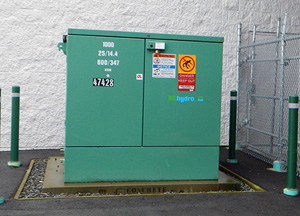
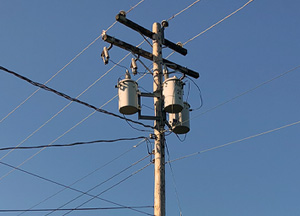
Hire a qualified electrical contractor
After we've discussed with you the work that needs to be done at your site, it's time for you to hire an electrical consultant or electrical engineer to do the work.
If you need help finding a qualified electrical professional, we can provide guidance by helping identify what type of service provider you need, and how to find service providers in your area.
For any of the upgrade options, your contractor will perform the work that takes place inside your building. We'll do any work needed on BC Hydro-owned equipment (whether it's on public or private property), and work with your contractor at key points to deenergize and reenergize electrical service.